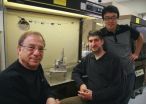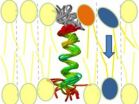(Press-News.org) (Santa Barbara, Calif.) –– A new, noninvasive, and low-cost method for the early detection and monitoring of osteoarthritis (arthritis caused by wear and tear) may be on its way, thanks to research by UC Santa Barbara scientists from the Department of Chemical Engineering and the Department of Materials.
By studying patterns of friction between cartilage pads, the researchers discovered a different type of friction that is more likely to cause wear and damage. Their work suggests ways to detect this friction, and points to new research directions for getting to the root cause of arthritis. The findings are published in the recent issue of the Proceedings of the National Academy of Sciences.
Imagine going to the doctor for your aching knees. For some, this may involve uncomfortable needle sticks to draw blood for lab tests, or the extraction of the fluid surrounding the aching joint. But what if your doctor could actually listen to your body, monitoring the way your knees sound as they bend and flex? Research by Jacob Israelachvili, UCSB professor of chemical engineering and materials science; grad student researcher Dong Woog Lee; and postdoctoral researcher Xavier Banquy says that it's possible.
For their work, they used an instrument called a Surface Forces Apparatus (SFA), a device that measures the adhesion and friction forces between surfaces, in this case cartilage –– the pad of tissue that covers the ends of bones at a joint. The degeneration of cartilage is the most common cause of osteoarthritis –– the pads wear away, leaving bone grinding against bone.
What the researchers found is that it isn't just any kind of friction that leads to the irreversible wear and tear on the material. "It is currently believed that a high-friction force, or 'coefficient of friction,' is the primary factor in surface wear and damage," said Israelachvili. "What we found is that this is not the case."
The critical feature is not a high-friction force, but what is known as "stick-slip" friction, or, sometimes, "stiction." Both are characterized by surfaces that initially stick together, and then accelerate away quickly once the static friction force is overcome. With stick-slip friction, the surfaces eventually pull slightly apart and slide across each other, stick again, and pull apart, causing jerky movements.
"That's when things get damaged microscopically," said Israelachvili.
Stick-slip is a common phenomenon. It is responsible for everything from computer hard drive crashes and automobile failures, to squeaking doors and music.
"The same thing happens with a violin string: Even if you're pulling the bow steadily, it's moving in hundreds or thousands of little jerks per second, which determine the sound you hear," Israelachvili said. Each little jerk, no matter how submicroscopic, is an impact, and over time the accumulation of these impacts can deform surfaces, causing irreparable damage –– first microscopically, then growing to macroscopic (large, visible) dimensions. That's when you have to change the string.
But it's not easy to tell the difference between types of friction at the microscopic level, where it all begins. Smooth-sliding joints might feel the same as those undergoing stiction, or the even more harmful stick-slip, especially in the early stages of arthritis. But, when measured with an ultra-sensitive and high-resolution instrument like the SFA, each type of friction revealed its own characteristic profile: Smooth-sliding joints yielded an almost smooth constant line (friction force or friction trace); joints with stiction showed up as a peak, as the "sticking" was being overcome, followed by a relatively smooth line; while stick-slip shows the jagged saw-tooth profile of two surfaces repeatedly pulling apart, sticking, and pulling apart again. According to the scientists, these measurements could be recorded by placing an acoustic or electric sensing device around joints, giving a signal similar to an EKG.
"With a well-designed sensor, this could be a good way to measure and diagnose damage to the cartilage," said Banquy. It could be used to measure the progression, or even the early detection of symptoms related to arthritis.
For a country that's facing a geriatric population explosion, dealing with issues associated with old age is no small matter. Early detection of conditions like arthritis has been a priority for many years, as baby boomers advance in age.
However, the functioning of joints is more complicated, said Israelachvili. The scientists will continue their work by studying synovial fluid –– the lubricating fluid between two cartilage surfaces in joints –– that also plays a major role in whether or not the surfaces wear and tear, and the synergistic roles of the different molecules (proteins, lipids, and polymers) that are all involved in lubricating and preventing damage to our joints.
"There are a number of directions to take, both fundamental and practical," Israelachvili said. "But it looks as if we need to focus our research on finding ways to prevent stick-slip motion, rather than lowering the friction force."
INFORMATION:
UCSB research provides insight into mechanics of arthritis
2013-01-30
ELSE PRESS RELEASES FROM THIS DATE:
Good mood helps boost brain power in older adults
2013-01-30
COLUMBUS, Ohio -- Older adults can improve their decision making and working memory simply by putting on a happy face, a new study suggests.
Researchers found that easy mood-boosters -- like giving people a small bag of candy -- helped seniors do significantly better on tests of decision-making and working memory.
This is the first study to show the power of positive moods in helping older people with these brain tasks.
"There has been lots of research showing that younger adults are more creative and cognitively flexible when they are in a good mood. But because ...
Cedars-Sinai Heart Institute study: Stem cells boost heart's natural repair mechanisms
2013-01-30
LOS ANGELES (Jan. 30, 2012) – Injecting specialized cardiac stem cells into a patient's heart rebuilds healthy tissue after a heart attack, but where do the new cells come from and how are they transformed into functional muscle?
Researchers at the Cedars-Sinai Heart Institute, whose clinical trial results in 2012 demonstrated that stem cell therapy reduces scarring and regenerates healthy tissue after a heart attack, now have found that the stem cell technique boosts production of existing adult heart cells (cardiomyocytes) and spurs recruitment of existing stem cells ...
Program to overcome early US math deficiencies could improve workforce
2013-01-30
COLUMBIA, Mo. -- One in five adults in the United States lacks the math competency expected of an eighth grader, according to the United States Center for Educational Statistics. University of Missouri researchers identified how a lack of a specific math skill in first grade correlated to lower scores on a seventh grade math test used to determine employability and wages in adults. Intervention programs designed to overcome this early math deficiency could prepare students for later employment, help them make wiser economic choices and improve the future U.S. workforce.
"Our ...
Vegetarianism can reduce risk of heart disease by up to a third
2013-01-30
The risk of hospitalisation or death from heart disease is 32% lower in vegetarians than people who eat meat and fish, according to a new study from the University of Oxford.
Heart disease is the single largest cause of death in developed countries, and is responsible for 65,000 deaths each year in the UK alone. The new findings, published in the American Journal of Clinical Nutrition, suggest that a vegetarian diet could significantly reduce people's risk of heart disease.
'Most of the difference in risk is probably caused by effects on cholesterol and blood pressure, ...
Erectile dysfunction drug also helps men ejaculate and orgasm
2013-01-30
NEW YORK (January 30, 2013) -- New data suggests the erectile dysfunction (ED) drug Cialis may also be beneficial in helping men who have problems with ejaculation and orgasm, report researchers from NewYork-Presbyterian Hospital/Weill Cornell Medical Center in the February issue of the British Journal of Urology International. Cialis is currently approved for the treatment of ED, benign prostate hypertrophy (BPH) and for treatment of men with both conditions.
Their study, a meta-analysis of 17 double-blind, placebo-controlled clinical trials of men with ED, is the first ...
Pathway for membrane building blocks
2013-01-30
The lipid molecules of membranes, also known as phospholipids, are composed of two elements: A hydrophilic head and two long-chain fatty acids. The molecules form a bilayer in the membrane, with all of the heads pointing outwards and the fatty acid chains hanging in a zip-like interlay position.
Biomembranes are constantly reorganized or renewed, for example whenever cells divide. The cell is constantly creating new phospholipids that have to align themselves – which they do in both layers of the biomembrane. However, cells only produce phospholipids on one side of the ...
How to be a social climber
2013-01-30
The researchers have carried out a social network simulation: each individual is represented by a node, while links, connecting the nodes, represent social interactions. Each individual has the tendency to enhance their social importance, and to do so they necessarily have to connect with the "most central nodes", that is, to the people who count. However, to advance socially an individual has to break with the past: technically speaking, abandon old nodes and connect with the most central ones. But how many have an inclination to break up with old connections to aim high? ...
Understanding the historical probability of drought
2013-01-30
Droughts can severely limit crop growth, causing yearly losses of around $8 billion in the United States. But it may be possible to minimize those losses if farmers can synchronize the growth of crops with periods of time when drought is less likely to occur. Researchers from Oklahoma State University are working to create a reliable "calendar" of seasonal drought patterns that could help farmers optimize crop production by avoiding days prone to drought.
Historical probabilities of drought, which can point to days on which crop water stress is likely, are often calculated ...
Broker fees from mutual funds affect advice; predict worse performance, new study says
2013-01-30
Toronto – Brokers are supposed to recommend investments that are in the best interests of their clients.
But a study published in the February 2013 issue of the Journal of Finance has found that mutual funds offering higher broker fees attract the most investments, especially when the broker is not affiliated with the mutual fund company. Every additional dollar paid to a broker corresponds with another six dollars invested into the fund, and another fourteen dollars if the broker is an unaffiliated third party whose compensation depends exclusively on sales commissions. ...
New target to stop cancer's spread discovered by Georgia State scientists
2013-01-30
Disrupting a key interaction between two types of proteins in cells inhibits the spread of cancerous cells, providing researchers with a new pathway toward developing cancer-fighting drugs, according to new findings by Georgia State University scientists.
Cell migration is essential for the spread of cancerous cells, also known as metastasis, as well as for other diseases. The research team in the labs of Zhi-Ren Liu, professor of biology, and Jenny Yang, professor of biochemistry, studied the interaction of two molecules, p68 RNA helicase and calcium-calmodulin.
Interrupting ...

